Brighten up your home with low-maintenance indoor plants that bloom all year long. There are a variety of colorful and inexpensive options on this list, all with the longest bloom time.
To get started, the general rule of thumb is to purchase mature plants rather than seeds, unless you have an abundance of patience and years to wait. Amaryllis is an exception, as it blooms from a bulb in just a few months.
As an added bonus, many blooming houseplants survive for years with minimal care, while others shine for a short period of time before fading. Take a look at our list and choose plants that will thrive in your home.
Best indoor flowering plants
1. Hoya Carnosa

If you are looking for houseplants that are beautiful and easy to grow indoors, you should consider hoyas, also called wax plants. They thrive in a variety of climates and are tolerant to low-light conditions. An interesting feature of this tropical house plant is its star-shaped waxy buds.
Plant’s Unique factor: It has attractive waxy foliage and sweetly scented flowers.
Botanical Name: Hoya Carnosa
Growing Conditions:
- Light: Bright light
- Water: Moderate
- Temperature: 65 °F
- Humidity: High humidity.
- Size: 20 feet in height
2. Pink Anthurium

This heart-shaped plant comes in different colors. Such as red, white, pink, or purple. Moreover, they are easy to grow indoors and bloom throughout the years. In indirect light, humid weather, and moist soil this plant grows well. However, be careful with this pretty plant, as they are poisonous.
Plant’s Unique factor: It has heart-shaped flowers and foliage.
Botanical Name: Anthurium andraeanum
Growing Conditions:
- Light: Medium to bright light
- Temperature: 65-80°F
- Water: keep soil evenly moist, barely moist in fall and winter.
- Size: 3 feet tall and 2 feet wide.
Note: This plant is poisonous and can cause illness if ingested.
3. Hydrangea

This brightly leaved plant is a great addition to any place. Welcome this beauty during spring, at that time they bloom.
A trick to keep Hydrangeas alive is to ensure their soil is moist. Also, position them in direct sunlight. If you met these two conditions, this plant will make a beautiful display in your home.
Plant’s Unique factor: Hydrangea has stunning large globes of flowers. In addition, they are low-maintenance plants.
Botanical Name: Hydrangea macrophylla
Growing Conditions:
- Light: Place them in a shaded location
- Water: Moderately to keep the soil moist
- Temperature: 65°F
- Soil: Well-drained, fertile
- Size: 2 feet tall and 3 feet wide
4. Orchids
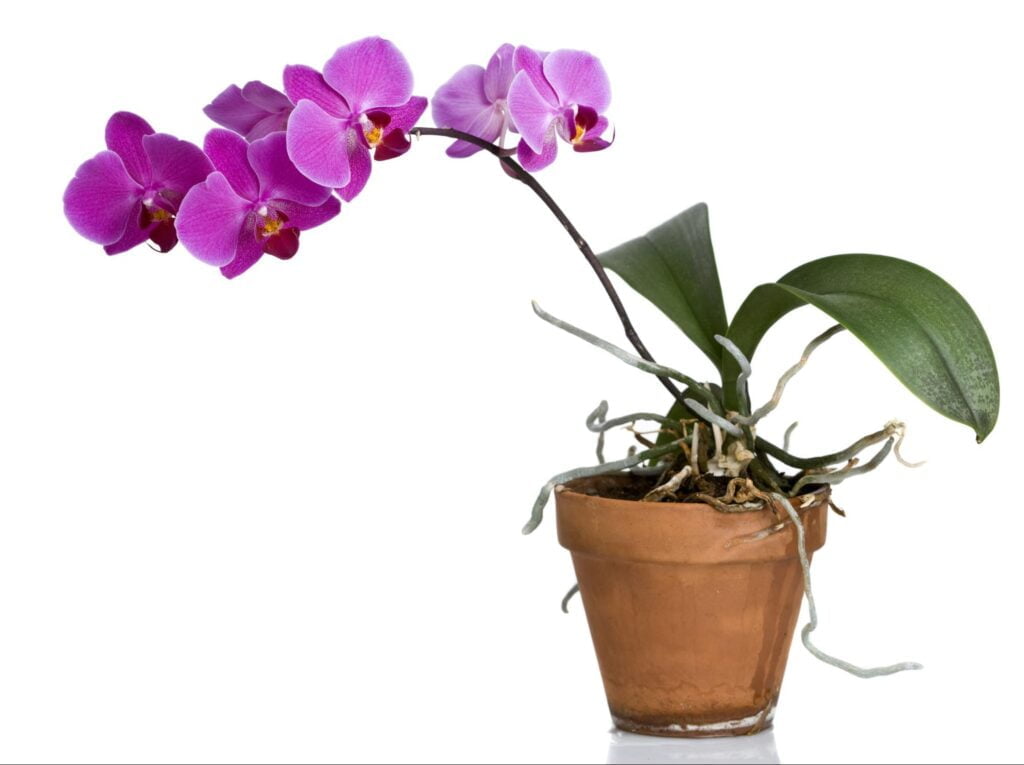
Do not misunderstand this delicate-looking orchid as a fragile plant. They bloom for months and survive for long years. That too with minimum care.
Orchids prefer bright, indirect light. Hence, east or west-facing window is the best location for them. Water them once a week until it drains out from the bottom of the pot.
Plant’s Unique factor: Orchids bloom colorful and fragrant. Also, they belong to one of the two largest families of flowering plants.
Botanical Name: Orchidaceae
Growing Conditions:
- Light: Bright light
- Water: Sparingly (but regularly)
- Humidity: High
- Size: 3 feet tall and 1 foot wide
5. White poinsettia

These white poinsettias are holiday faves. However, they bloom for months under favorable conditions. While selecting poinsettias, choose one that has little flowers, in the center, not one that is shedding pollen. This means the plants are past their prime and won’t last through the season.
While bringing the plants home, cover them. Especially if it is cold. Water them when they are dry to touch. However, do not allow them to sit in water. As they are finicky about reblooming, consider replacing them next year.
Plant’s Unique factor: The color of poinsettias changes as the winter days shortens. Poinsettia flowers are made of bracts, which resemble petals, and tiny yellow flowers inside called cyathias.
Botanical Name: Euphorbia leucocephala
Growing Conditions:
- Light: Indirect sun
- Temperature: 60 and 70 ℉
- Water: Keep the soil moist
- Size: 2 feet tall
6. Gloxinia
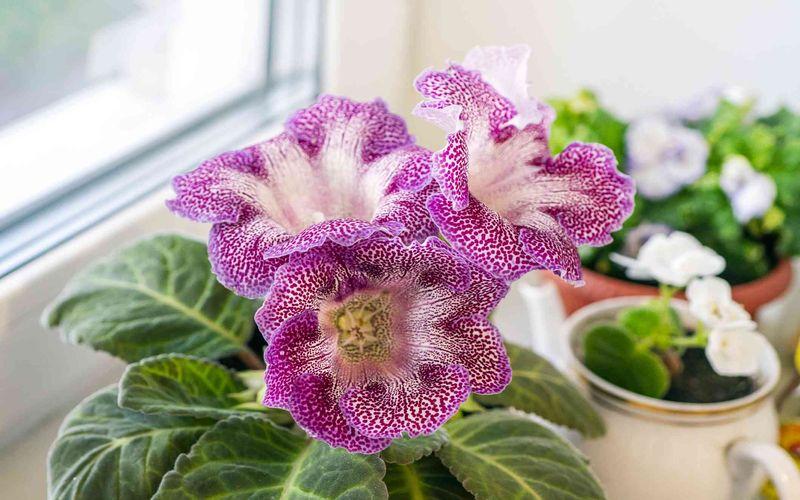
Gloxinia is a relative of African violets. Like African violets, this plant has beautiful frilly flowers along with deep green leaves. The best time to carry this plant is in winter as per many nurseries and florists.
Gloxinia loves bright filtered light and moderately moist soil. But they do not like to get their leaves wet. You can enjoy their long flowering period (about 2 months), however, they are notoriously finicky about reblooming.
Plant’s unique factor: The huge, bell-shaped flowers are so attractive.
Botanical Name: Sinningia speciosa
Growing Conditions:
- Light: Medium to bright light;
- Temperature: 65-80°F, 55-75°F
- Water: Keep soil evenly moist except when dormant
- Size: 1.5 feet tall and 2 feet wide
7. Christmas Cactus
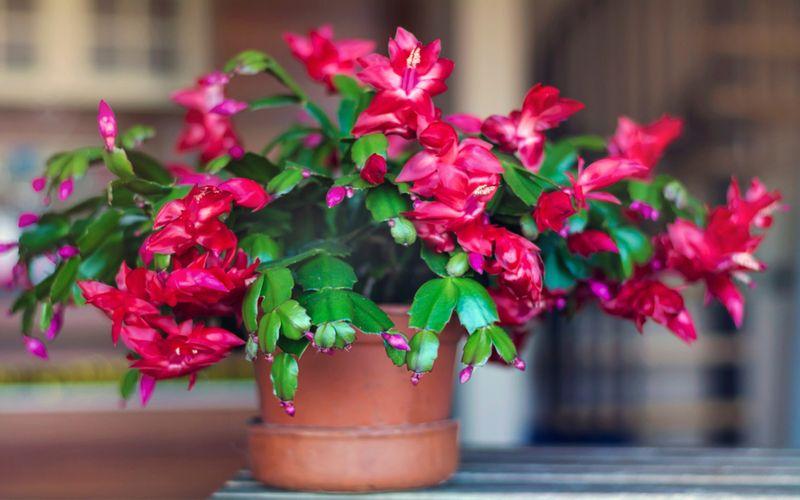
These old-fashioned are popular for good reasons. Firstly, the cacti are not fussy and they can live for decades! Their exotic-looking blooms have beautiful shades. Additionally, they range from pure white to pink and red.
However, different varieties of this plant bloom at different times of the year. The Christmas cacti enjoy bright indirect light. Water them when the topsoil is dry. Do not allow water to sit in the saucer.
Plant’s unique factor: It’s an old-fashioned favorite with exotic-looking blooms.
Botanical Name: Schlumbergera x buckleyi
Growing Conditions:
- Light: Bright light
- Temperature:70-80°F, 55°F in fall
- Water: Moderately
- Size: 1 foot tall and 1.5 feet wide
8. African violet
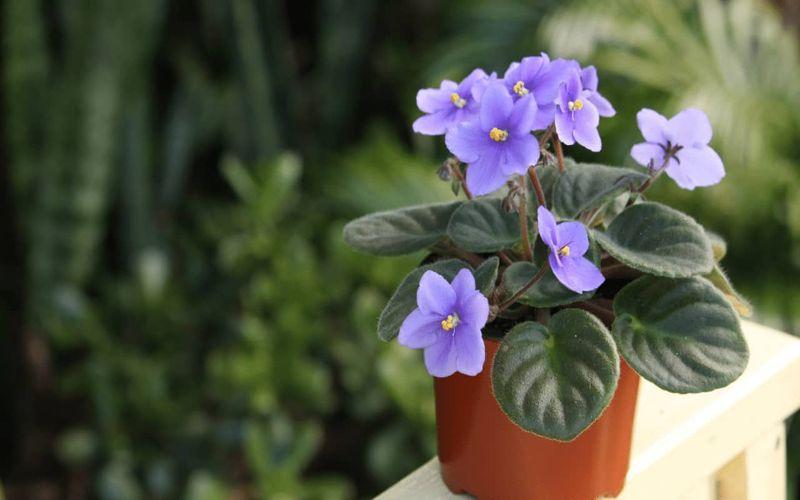
These dainty-looking plants come in the shade of purple, pink, and white. Moreover, they bloom almost continuously. Some of the African violets are known to live for decades.
This plant loves to soak up indirect light on a window ledge. Avoid water dripping on the fuzzy leaves as it can cause brown spots.
Plant’s unique factor: In a bright window, the plants bloom almost constantly. It’s fun to collect varieties with all sorts of flower colors and shapes.
Botanical Name: Saintpaulia ionantha
Growing Conditions:
- Light: Medium to bright light;
- Temperature: 65-75°F
- Water: Keep soil evenly moist
- Size: 8 inches tall and 16 inches wide
9. Kalanchoe

Kalanchoe is a succulent that boasts glossy green leaves. Also, it blooms bright red, yellow, pink, or orange. These clusters of flowers last for weeks.
This plant does best in bright indirect light. Additionally, they like to dry out between waterings.
To enjoy the foliage all year long, prune off the flower head after it fizzles.
Plant’s Unique factor: The kalanchoe produces lots of flowers during its blooming season.
Botanical Name: Kalanchoe blossfeldiana
Growing Conditions:
- Light: Bright, indirect sunlight
- Water: Do not need lots of watering
- Soil: Well-drained
- Size: 3 feet tall and wide
Note: The plant is toxic to both pets and humans.
10. Hibiscus

Under the right indoor conditions, the hibiscus plant grows stunningly. Though its large flower lasts for a few days they stay in bloom from spring to fall. Moreover, hibiscus can live for several years. Just provide bright light to keep them blooming. Additionally, evenly moist soil in summer and slightly dry in winter.
Plant’s Unique factor: These plants have large, colorful blooms and are fast-growing.
Botanical Name: Hibiscus
Growing Conditions:
- Light: Bright direct sunlight
- Water: Water until the soil is moist
- Temperature: 60-90°F
- Size: 3 feet tall and 2 feet wide
11. Peace lily
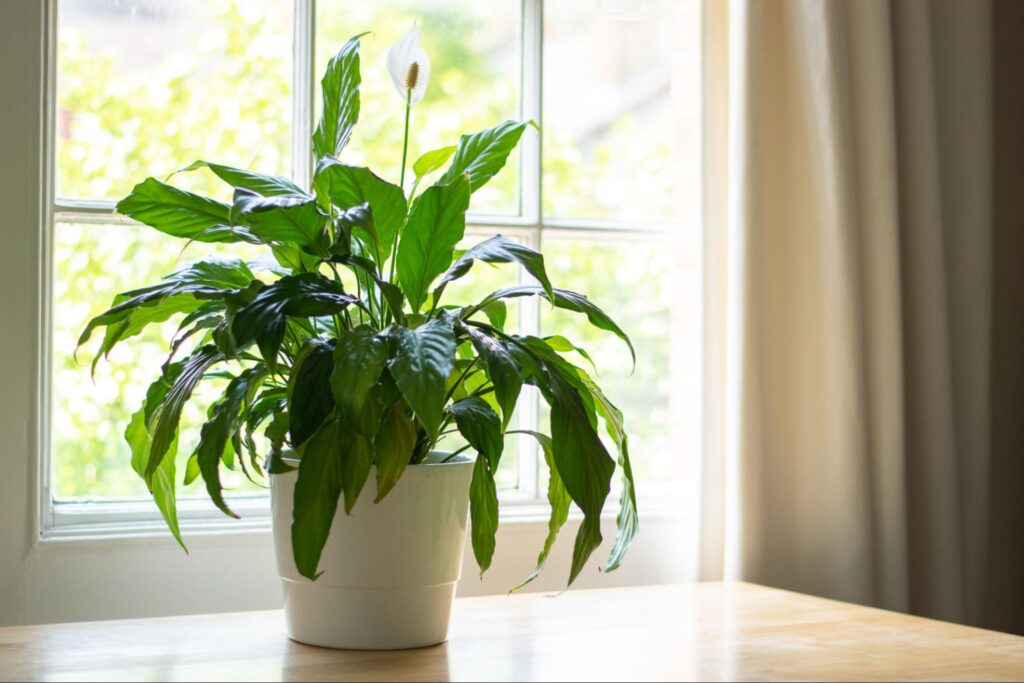
Glossy green leaves with spoon-shaped flowers make the Peace lily a great addition to the houseplant collection. Under favorable conditions, this plant last for many years with minimum care.
In light, peace lily prefers low to moderate light. However, they tend to bloom better with bright filtered light. Also, they enjoy moist soil but are not soggy.
Plant’s unique factor: Its large, deep green leaves give an instant tropical touch to any room. Also, it’s one of the easiest flowering indoor plants you can grow.
Botanical Name: Spathiphyllum wallisii
Growing Conditions:
- Light: Low to bright light
- Temperature: 60-85°F
- Water: Keep soil evenly moist
- Size: 6 feet tall and 5 feet wide
Note: This plant is poisonous if ingested.
12. Flowering Maples
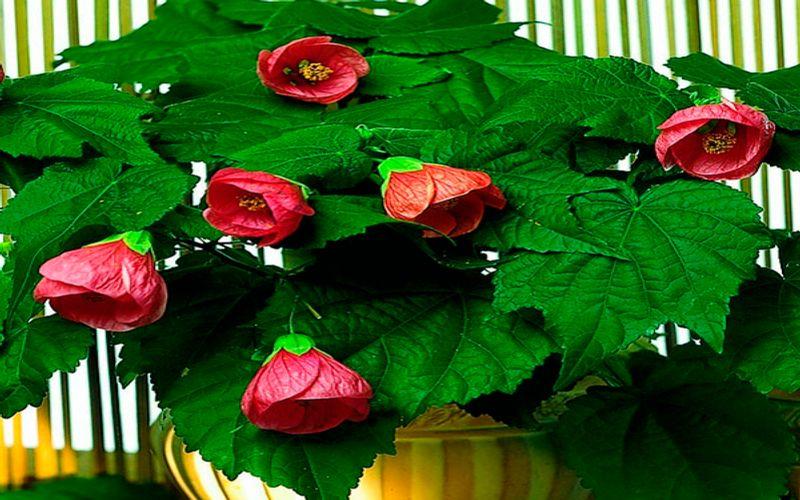
Flowering Maple also known as abitilon blooms red, yellow, or pink. This plant lasts a few years before getting leggy and unattractive. This maple plant prefers bright indirect light. Hence, placing them by a window with south or west exposure will be ideal for their growth. For the best results, water them whenever topsoil feels dry to the touch.
Plant’s unique factor: This is a fast-growing plant that constantly blooms.
Botanical Name: Abutilon x hybridum
Growing Conditions:
- Light: Bright to intense light
- Temperature: 65-75°F
- Water: Keep soil evenly moist
- Size: 5 feet tall and 3 feet wide
13. Clivia
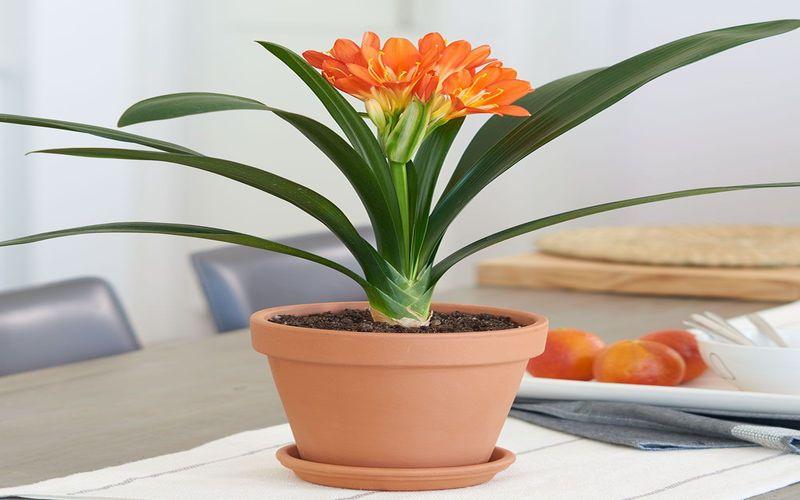
This elegant plant has long-lasting flowers. It blooms orange or yellow flowers with long, strappy glossy leaves. Moreover, it tolerates most light conditions. Though it is a long-lived plant, getting them to rebloom is a bit tricky.
Keep this plant outside in fall, after that move them to the coolest room before the first frost. Keep the Clivia plant dry until midwinter, then you can increase water gradually. If you follow this, you can expect blooms in February or March.
Plant’s unique factor: Its elegant blooms last long.
Botanical Name: Clivia miniata
Growing Conditions:
- Light: Medium light
- Temperature: 60-75°F, 50-55°F in winter
- Water: Keep the soil barely moist
- Size: 2 feet tall and wide
Note: This plant is poisonous and can cause illness if chewed on.
14. Amaryllis

During the fall, Amaryllis flowers form bulbs. At that time, it is best to place them in a bright spot. Less light causes amaryllis to flop over. Also, it is important to keep their soil evenly moist. Amaryllis blooms occur about 6 weeks later and you can enjoy their blooms for more than a month.
To get amaryllis to rebloom next year, save the bulb and leave their foliage intact. However, cut the faded flower stalk and move them into shade after the last frost.
In late summer, allow the bulb to go dormant. Next, cut off the foliage and avoid watering until November. After that start to water them and cross your fingers!
Plant’s Unique factor: They make wonderful gifts for gardeners ranging from beginners to experts and add vibrant color to a home or garden.
Botanical Name: Amaryllis
Growing Conditions:
- Light: Bright sunlight
- Water: Do not wet the bulb above the soil.
- Temperature: 60℉
- Size: 4-10 inches tall
15. Cyclamen
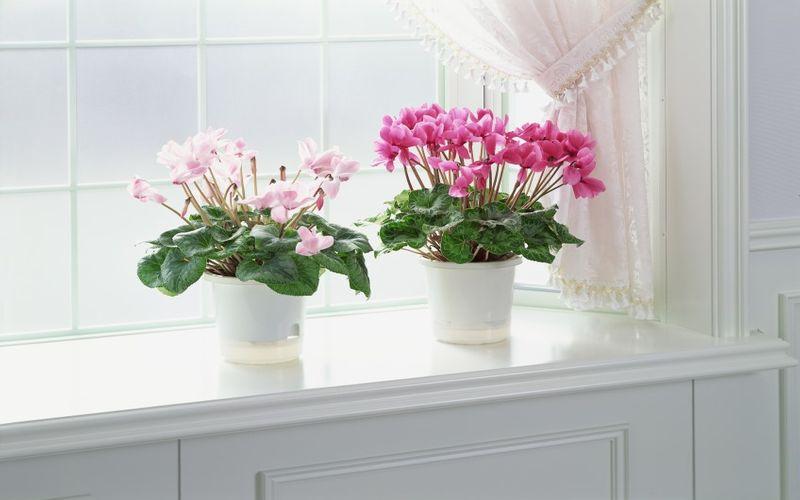
Floating over heart-shaped leaves, these blooms are pink, lilac, red, or white, with new blooms appearing for months. They need bright light and light moisture. Also, cool temperatures are preferred (60 to 70 degrees), otherwise, the leaves tend to yellow and die. This plant is hard to rebloom, so enjoy it while it is at its peak.
Plant’s Unique factor: These leaves are heart-shaped and made up of intricate pale green patterns, sprouting from a central point.
Botanical Name: Cyclamen sp.
Growing Conditions:
- Light: Bright indirect
- Water: Keep the soil lightly moist
- Soil: Rich, well-draining, and acidic
- Size: Up to a foot in height and width
16. Bromeliads

This beautiful plant come in a variety of vibrant colors. Moreover, they are easy to care for. Also, they don’t need much water. In addition, their blooms last up to two to three months.
Plant unique factor: Its colorful red, orange, yellow, or purple flower bracts give a tropical and exotic look.
Botanical Name: Guzmania lingulata
Growing Conditions:
- Light: Bright light
- Temperature: 65-80°F, 60-65°F in winter
- Water: Keep the soil moderately dry
- Size: 3 feet tall and wide
17. Chrysanthemums

Add this plant to your home if you want an easy indoor flowering plant. You will need to provide very little care. Only keep their soil moist and ensure their pot has good drainage.
Plant’s Unique factor: It is the second most popular cut flower in the world, after the rose.
Botanical Name: Chrysanthemum
Growing Conditions:
- Light: Full sunlight
- Water: Frequent watering
- Soil: Well-drained
- Size:1-3 feet
18. Begonia
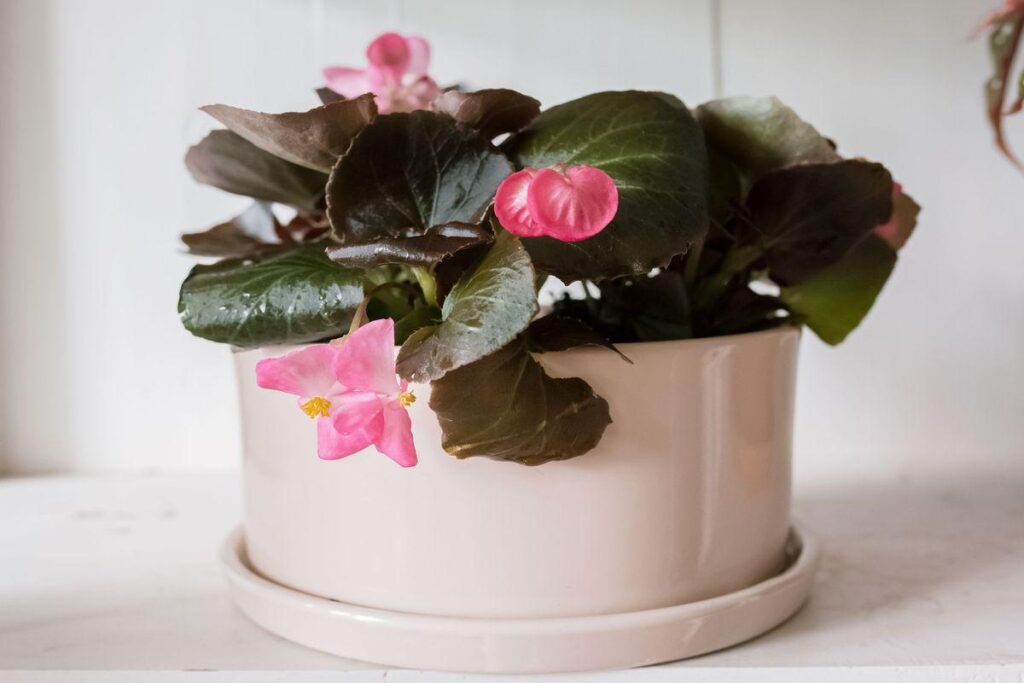
This hardy perennial plant blooms bright. Hence it is a perfect addition to your home and garden. Also, you will get many different shapes, colors, and sizes in Begonia. Additionally, it is easy to grow and take care of both indoors and outdoors.
The best types of begonias you can grow indoors are; Wax Begonia, Angel-wing Begonia, and Rieger Begonia
Plant unique factor: Begonia’s beautiful wing-shaped leaves are as attractive as the blooms so it’s pretty all year long.
Botanical Name: Begonia spp.
Growing Conditions:
- Light: Medium to bright light
- Temperature: 65-75°F
- Water: Keep soil evenly moist
- Size: 6 feet tall and 3 feet wide
Note: The roots and stems of begonia can cause painful irritation of the mouth, lips, or throat if eaten or chewed on.
19. Scented geranium
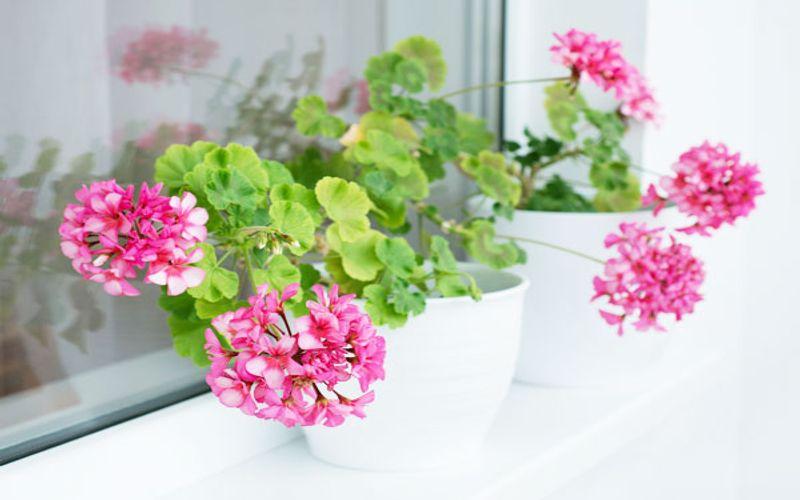
While scented geraniums do bloom, the flowers are often secondary in importance. Moreover, they are not all attractive. Geranium is mainly grown for its attractive and highly scented foliage.
Fragrances can run from apple to mint to lemon to coconut to rose. Because they will not overwinter outdoors in cold climates they are best grown as potted indoor flowering plants so they can be moved indoors in colder months.
Plant unique factor: The bloom colors are so vibrant.
Botanical Name: Pelargonium spp.
Growing Conditions:
- Light: Bright to intense light
- Temperature: 60-75°F
- Water: Keep soil moderately dry
- Size: 3 feet tall and wide
20. Jasmine

This vine is intoxicatingly fragrant. Due to this reason, they are widely grown as indoor flowering plants.
Provide jasmine some direct sunlight in the summer, constant moisture throughout the year (although a bit drier in the winter), and cooler temperatures in the fall to encourage flowering.
Jasmine is much more cold-tolerant than many people think and have no problem tolerating fall temperatures of 40℉.
If your Jasmine doesn’t bloom, chances are it didn’t get a cool period in the fall. That it needs to stimulate blooms.
In case, you have never grown jasmine indoors before, start with J. polyanthum –this is much easier to handle.
Plant unique factor: The beautiful pink or white blooms are the most fragrant you will find on any houseplant.
Botanical Name: Jasminum spp.
Growing Conditions:
- Light: Bright to intense light
- Temperature: 60-75°F, 40-60°F in winter
- Water: Keep soil evenly moist
- Size: 4 feet tall and 6 feet wide
21. Chenille plant
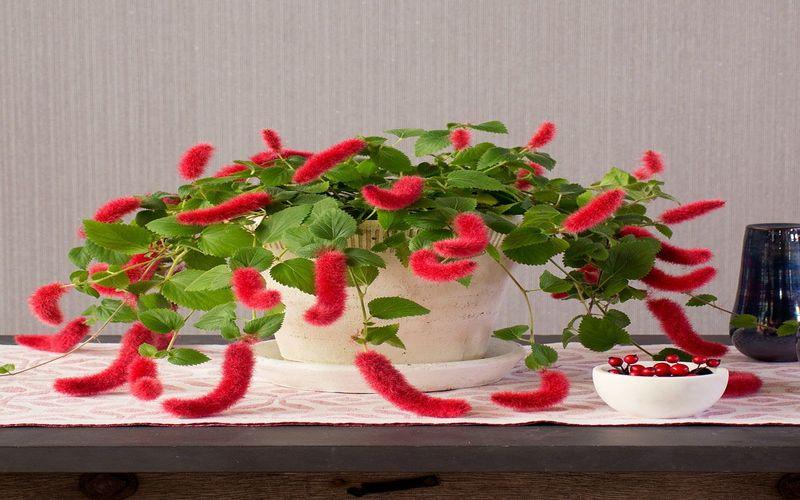
This is a flowering shrub that belongs to the Euphorbiaceae family. Also, Chenille is hardy in a frost-free area where it is used as a year-round flowering shrub. Mostly this plant is sold as a spring or fall flowering potted plant.
Moreover, the chenille is well suited to the flowering border or large container plantings on the patio.
Provide them full sun, routine fertilization during the growing season to promote new growth coming, and normal watering frequency.
Plant’s Unique factor: The stems of this plant are sparsely branched and bear heart-shaped, bright green leaves with teethed margins.
Botanical Name: Acalypha hispida
Growing Conditions:
- Light: Full sun
- Water: Frequent watering
- Soil: Well-drained
- Size: 15 feet tall and 8 feet wide
22. Silver vase plant
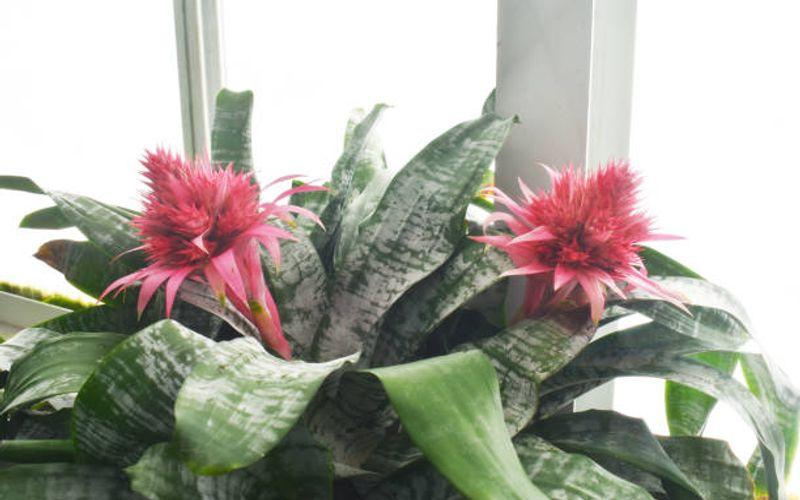
Silver Vase, commonly known as Aechmea Fasciata, is a species of bromeliad that has beautiful flowers. The silver-grey, banded foliage of this easy-care bromeliad makes a perfect backdrop for the colorful stalks of flowers. These stalks of flowers emerge from the tight center rosette.
Their flower stalk is composed of a cluster of rosy pink bracts which nestle pale blue flowers. These flowers change to deep roses. Moreover, it is the long-lasting pink bracts that are most noticeable.
Silver plants grow best in partial shade in moisture-retentive but well-drained soil.
Plant’s unique factor: silver vase plant is one of the most dramatic, easy indoor plants you can grow.
Botanical Name: Aechmea Fasciata
Growing Conditions:
- Light: Bright light
- Temperature: 65-75°F
- Water: Pour water into the vase formed by the foliage rather than onto the soil
- Size: 3 feet tall and wide
23. Oxalis

Oxalis is a low-growing foliage plant. They are so attractive indoor plants with rich, vibrant, purple leaves.
The main reason you will enjoy growing oxalis is that their flowering is highly photophilic. This means that they open and close not just their flowers but also their leaves in response to light.
Isn’t it so dramatic to watch oxalis growing?
Plant’s unique factor: The oxalis leaves are striking. Plus, it makes an ideal gift for a plant lover.
Botanical Name: Oxalis triangularis
Growing Conditions:
- Light: Medium to bright light
- Temperature: 60-75°F
- Water: Keep soil evenly moist
- Size: 1 foot tall and wide
24. Crown of thorns
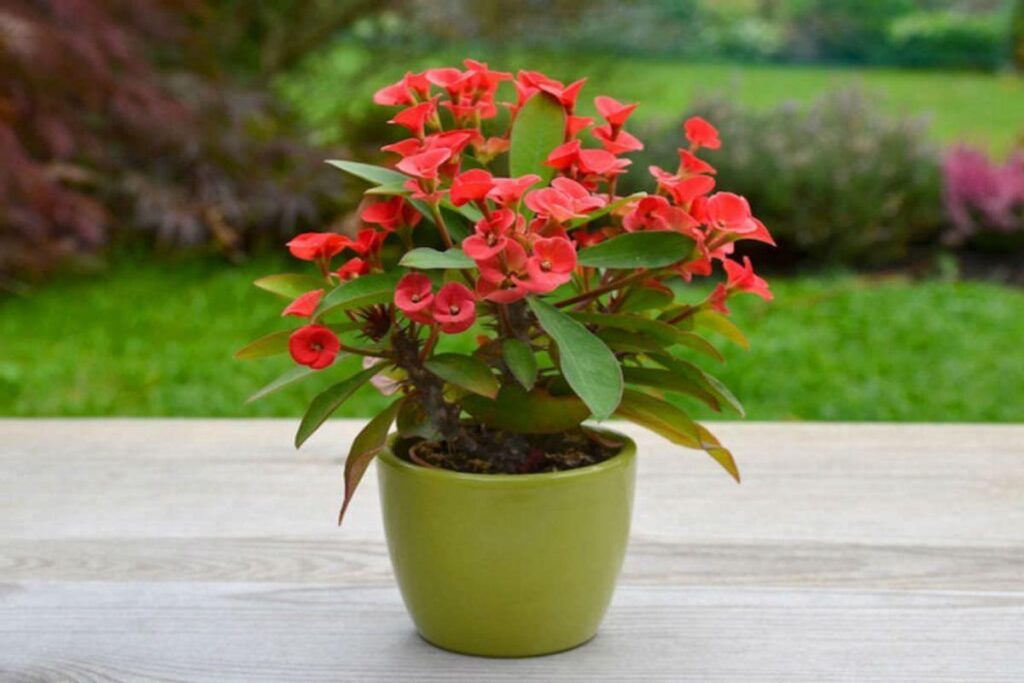
If you need a unique indoor plant, a crown of thorns plant is the best choice. This succulent has thick fleshy leaves. They are a great choice for warmer areas as they are heat tolerant.
As it does not mind drying out, it makes a great flowering potted plant.
Plant’s unique factor: It’s an easy-care, low-water plant whose colorful bract-like flowers last for weeks.
Botanical Name: Euphorbia milii
Growing Conditions:
- Light: Bright to intense light
- Temperature: 65-75°F
- Water: Keep soil moderately dry
- Size: 3 feet tall and wide
Note: This plant is poisonous and the milky sap can cause illness or skin irritation if ingested by children or pets. It’s also very thorny.
25. Cape Primosa
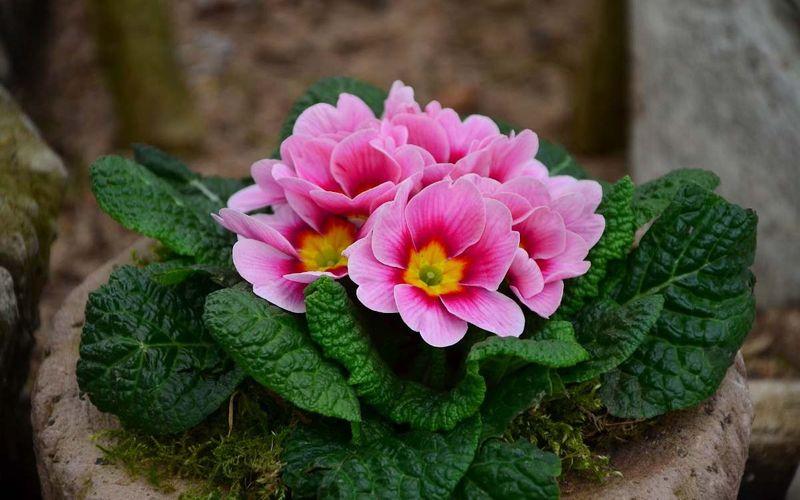
African Violets (Streptocarpus) are close relatives of Cape Primrose (Streptocarpus) and prefer bright but indirect light for growth.
Green, velvety leaves rise above their foliage, making them the perfect plant for your windowsill.
Warm, dry surroundings with temperatures ranging from 60-75 ℉ are ideal for these plants.
Plant’s Unique factor: The leaves of this plant are long, deep veined, and arranged in a rosette.
Botanical Name: Streptocarpus x hibridus
Growing Conditions:
- Light: Bright indirect light
- Water: Keep the soil lightly moist
- Soil: Well-drained
- Size: 1 foot tall and 1.5 wide
26. Guppy plant

Another African violet relative, the Guppy plant blooms mainly in the summer, but with enough light, it can bloom throughout the year.
Its dramatic flowers resemble dangling goldfish, making it a great choice for hanging baskets.
Plant’s unique factor: How can you not love a plant whose flowers look like goldfish! It’s a great houseplant for getting children excited about plants.
Botanical Name: Nematanthus spp.
Growing Conditions:
- Light: Medium to bright light
- Temperature: 65-80°F, 50-55°F in winter
- Water: Keep the soil moderately dry
- Size: 2 feet tall and 3 feet wide
27. Indian Mallow
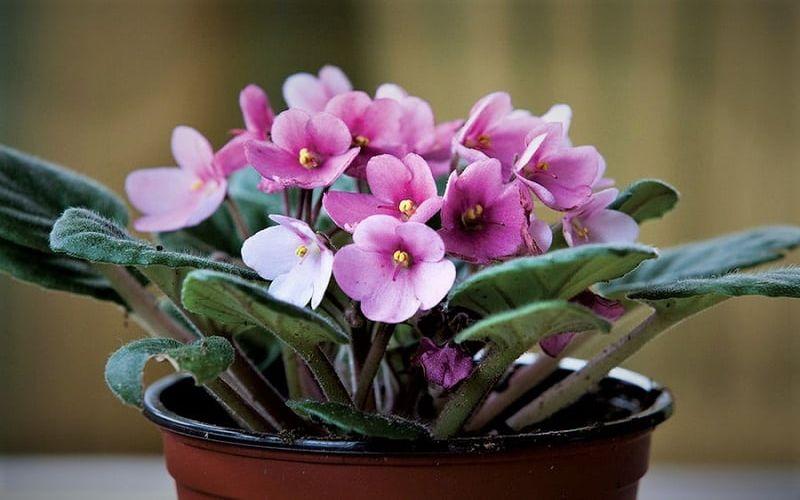
The Indian Mallow, commonly known as Abutilon fruticosum, is a large genus of indoor flowering plants in the Malvaceae family.
There is a long period of time during the spring when the orange, almost poppy flowers reappear on the soft gray sublunar plants.
Do you have a drywall that burns out everything? A wall-like that would be ideal for this plant, as long as it does not get too wet in winter nor too dry in early summer.
Plant’s Unique factor: These plants are highly versatile, which makes them a great addition to a variety of indoor and outdoor settings
Botanical Name: Abutilon
Growing Conditions:
- Light: Full sun to light shade
- Water: Moderate
- Soil: Well-drained
- Size: 8 feet tall and 5 feet wide.
28. Shrimp plant
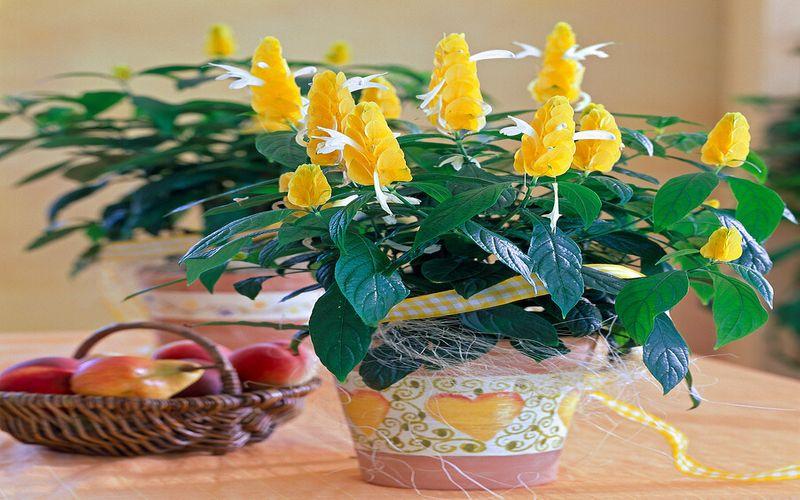
As a result of its color and tightly packed bracts, the general appearance is reminiscent of boiled shrimp.
As long as there is a sunny window nearby, this plant can be used as a potted plant to bloom during the winter. During the summer months, if used in a patio planting, provide a bigger planter with ample root room.
Plants in this family are often known for their moisture-loving habits, but the Shrimp plant can withstand dry conditions.
Plant’s unique factor: Its flowers are so unique, and resemble shrimp. Your guests will definitely notice it.
Botanical Name: Justicia brandegeeana
Growing Conditions:
- Light: Bright to intense light
- Temperature: 60-75°F
- Water: Keep soil evenly moist
- Size: 3 feet tall and 2 feet wide
29. Brazilian fireworks plant

There are purple and pink spikes of tubular flowers on the Brazilian Fireworks Plant, and they are so beautiful.
When they receive enough warmth in your house, office, or garden, the plant grows all year round.
This plant makes an eye-catching houseplant because of its bright flowers and leaves that are accented with silver veins.
Plant’s unique factor: It’s always attractive. You never have to worry about what it looks like when it’s done blooming as the green leaves have eye-catching silver markings.
Botanical Name: Porphyrocoma pohliana ‘Maracas’
Growing Conditions:
- Light: Medium to bright light
- Temperature: 65-80°F
- Water: Keep soil evenly moist
- Size: 1 foot tall and 2 feet wide
30. Lipstick plant
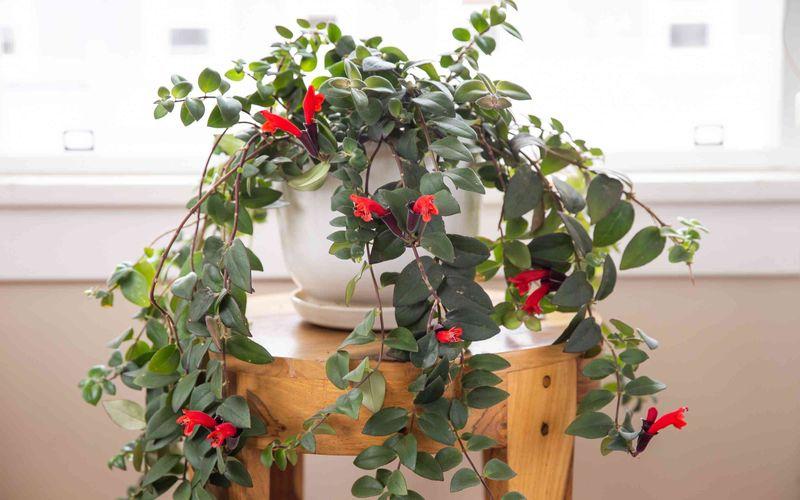
Aeschynanthus pulcher is commonly known as the Lipstick plant because of its bright red tubular flowers.
Slow-release or liquid fertilizers with a 3-1-2 ratio can achieve excellent growth. Also, you can add micronutrients to the potting medium or include them in the fertilization program.
Potting media used should have excellent aeration, although ample moisture is necessary. Good growth of lipstick plant occurs when minimum potting mix temperatures are 70 to 80°F, with similar air temperatures.
Plant’s Unique factor: Lipstick plant is an easy-to-grow plant with flashy red flowers that really do look like little tubes of lipstick.
Botanical Name: Aeschynanthus radicans
Growing Conditions:
- Light: Medium light
- Temperature: 60-80°F
- Water: Keep soil evenly moist
- Size: 20 inches tall and 36 inches wide
31. Ixora

One of the best things about this plant is that it flowers throughout the year! Each flower cluster can last between 6-8 weeks giving your landscape long-lasting and beautiful color.
Ixora comes in a wide range of colors including bright red, orange, yellow, pink, and white. Moreover, they bloom continuously under ideal conditions. While full sun is essential for maximum flower production, this plant—especially large-leaved varieties can tolerate partial shade.
Plant’s unique factor: Its big clusters of orange, pink, red, or yellow flowers are wonderful treats on winter days.
Botanical Name: Ixora coccinea
Growing Conditions:
- Light: Bright light
- Temperature: 65-80°F
- Water: Keep soil moderately dry
- Size: 5 feet tall and 4 feet wide
Conclusion:
As you have seen the varieties of beautiful indoor plants. These amazing-looking plants have the ability to add bright color to any indoor space.
They will function as part of the home decor while providing a variety of benefits. After all, indoor plants have known to enhance life satisfaction, increase creativity and even boost your self-esteem.
So, what are you now waiting for? Pick one from the list and enjoy growing the beautiful flowering plants.
FAQs About Indoor Flowering Plants
How to take care of indoor flowering plants?
You need to make sure the potting soil is moist. Apart from this, you need to pick planters that have drainage holes at the bottom. Ensuring proper sunlight and water for the indoor flowering plants are counted as crucial steps.
What are the benefits of Orchid flowers?
Orchids are usefulness in the creation of medicines which help in relaxation. In fact, dried orchids are known to strengthen the immune system that eventually makes your body fight infections.
What is the usefulness of oil extracted from Geranium Pelargonium Plant?
The oil extracted from Geranium has antibacterial as well as insecticidal properties. Furthermore, it is also used in Aromatherapy.
What is the soil specification and care for Lavender plant?
Before you plant, must to enrich the soil using manure or compost. If the soil is strongly acidic, you need to add a dose of lime. Lavender plants are drought hardy; however, occasional soaking during warmer months is necessary.
How much sun does hibiscus need?
It is important for you to give your tropical hibiscus plant a lot of sun. In fact, the higher amount of direct sun they get, the better they will bloom. You should provide them with a sun for at least six to eight hours for a prime flowering hibiscus plant. If you are okay with not too many flowers, you can also grow them in shade.

